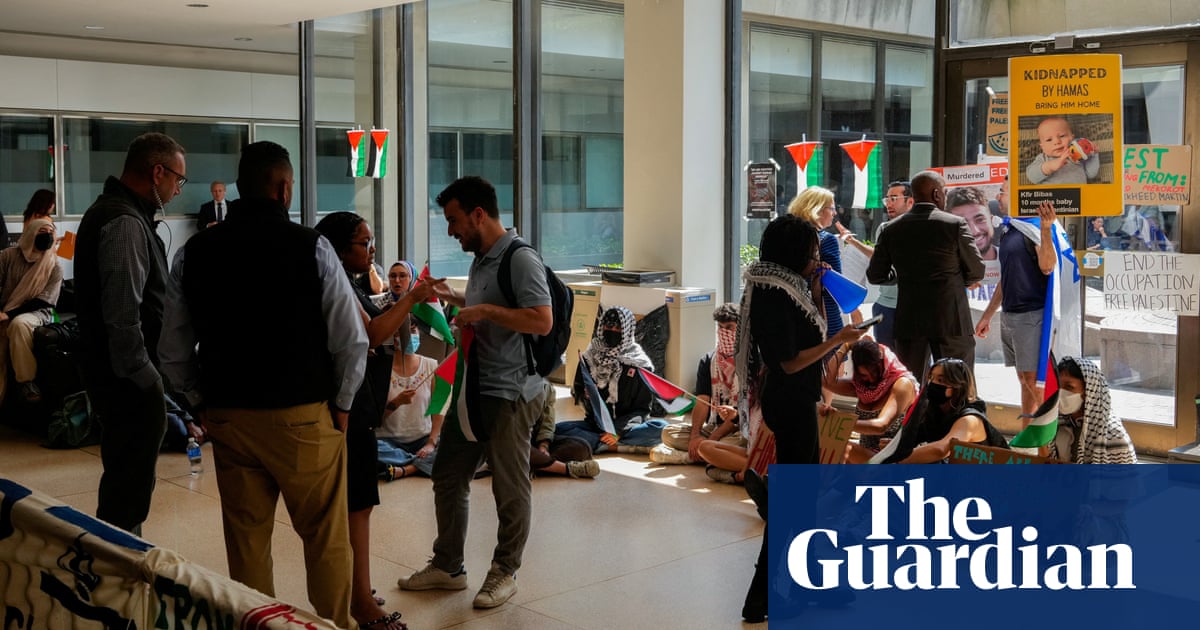Columbia University students returned to campus this week under the specter of the mass protests that disrupted campus life last semester. But while actions against the Gaza war continue, the first days of class saw little of the last school year’s chaos.
On Wednesday, a group of about 30 students gathered for a sit-in protest outside a class Hillary Clinton teaches at the School of International and Public Affairs building, chanting “intifada revolution” and “Zionists not welcome here”.
“Clinton [is] a politician who has benefited off the backs of the global south,” one of the protesters said in a speech. Campus security briefly told her to lower her volume, but the protest was allowed to proceed. Three counterprotesters were also there, quietly standing with Israeli flags over their shoulders as they held up a hostage poster.
The day before, on the first day of classes, a group of 50 students donning keffiyeh scarves marched in a tight circle outside the campus gates on Manhattan’s Broadway, forming a picket line and urging students and faculty to boycott classes. Two students were arrested and later released.
Behind the protest, many more students lined up to scan their ID cards to enter campus, a new security measure designed to limit entry to staff, students or pre-arranged visitors. Private security stood guard at each entry point.
Once inside, students ate free ice cream handed out by Katrina Armstrong, the university’s interim president, while enjoying the summer sunshine on the lawns.
The campus carries few remnants of the encampment protests held last spring. Black fencing had been put up around green spaces. A new plaque noted that “camping” was prohibited.
Arya Kaul, a sophomore, described a “solemn” mood on campus. “It’s supposed to be an open campus, [but] you’re a lot more trapped … right in the middle of New York City,” she said.
Earlier on Tuesday morning, someone splashed red paint on to the large Alma Mater statue outside Low Library. It was cleaned up within hours.
The university’s previous president, Minouche Shafik, resigned this summer amid criticism of her handling of the campus protests, which saw more than 100 students arrested in April. Most of the arrests came as NYPD officers cleared out Hamilton Hall, where protesters had barricaded themselves, and the tent encampment on the lawn outside.
Student protesters – largely united under a coalition called Columbia University Apartheid Divest – are demanding that the university disclose its investment portfolio and divest from companies profiting “from Israeli apartheid, genocide, and military occupation of Palestine”. Examples include weapons manufacturers and tech companies with ties to or operations in Israel, such as Amazon, Google, Lockheed Martin and more.
But while tensions haven’t reached a boil this semester, they are simmering. Doxxing vans paid for by the rightwing group Accuracy in Media have returned outside the university, with names and faces of protesters appearing under the banner “Columbia’s Leading Antisemites”.
Critics of the demonstrations, including some Jewish students, have alleged antisemitism on the part of the protesters, who have rejected the charges and say they are focused on the Israeli state and institutions that support it. In the aftermath of the protests, Columbia’s antisemitism taskforce recently found an “urgent need” for change and called on the university to require training for incoming students on antisemitism and Islamophobia.
In an email to students this week, Armstrong said the rules of university conduct committee was working to “support the University’s commitment to freedom of expression while identifying potential violations of conduct”.
Revised protest guidelines require organizers to inform the university of any scheduled protests, prohibiting any demonstrations that pose “a genuine threat of harassment” or “substantially inhibit the primary purposes” of university space.
“We fully expect these rules to be broken,” Richard Smiley, professor of anesthesiology and a member of the rules committee, said last month. “But given the events of last year, we felt it important to set up very clear guidelines for how to adjudicate.”
Free speech experts have expressed alarm at restrictions proliferating on American campuses. Columbia’s new rules represented a “heavy-handed approach” with some “pretty restrictive policies”, said Laura Beltz, director of policy reform at the Foundation for Individual Rights and Expression (Fire).
“I’m concerned students may be discouraged from free expression on campus,” she explained, anticipating a “chilling effect” at Columbia and elsewhere.
Despite the relative calm, some students are worried about what’s to come.
“Professors didn’t have a plan for finals [last spring],” said Jiaqi Yuan, a graduate student. Exams last year were switched at the last minute to offer a remote model, with some being postponed. “Students study hard … and don’t want scheduling problems like last year,” she added.
While organizers are not broadcasting their plans, they have vowed to continue their protests.
On Thursday, Columbia Students for Justice in Palestine released an anonymous student’s statement reading: “Even after being brutalized and arrested, that’s not ever going to be enough to keep us silent when there’s a genocide happening.
“When people are losing their lives just for being Palestinian, the least I can do is use my voice, which is completely within my rights.”
